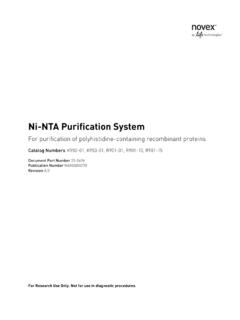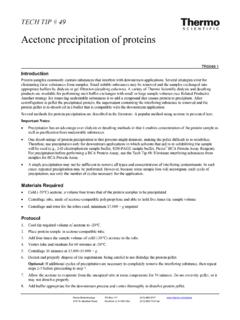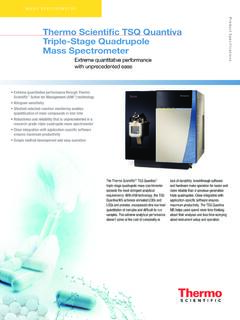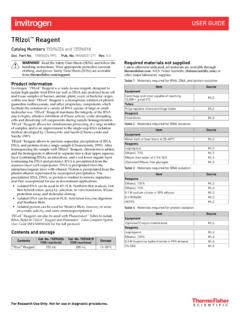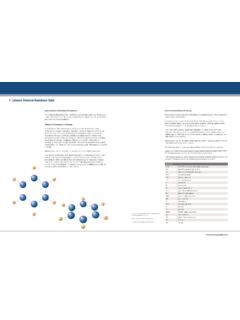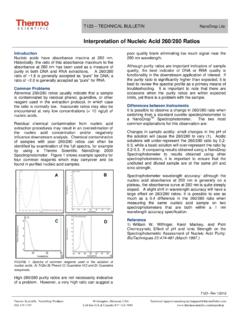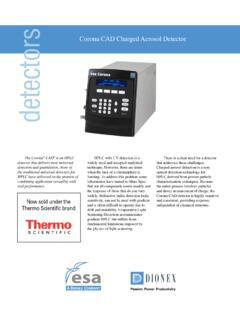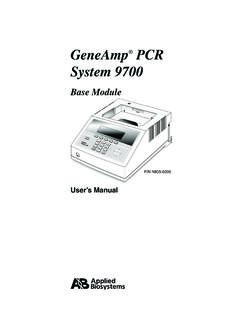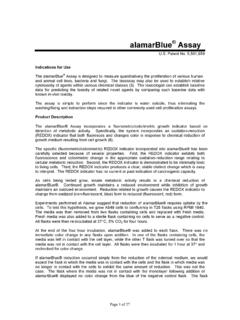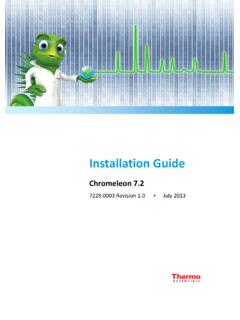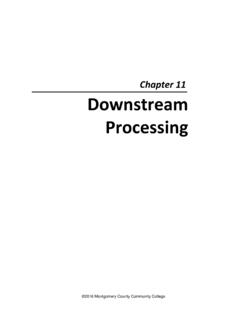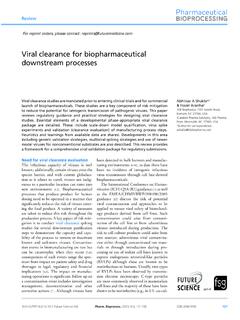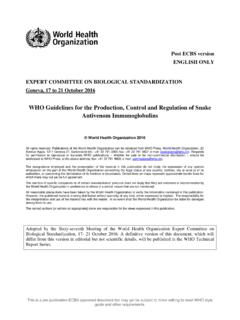Transcription of Antibody Production Purification Guide
1 Version 2 Thermo Scientific Pierce Antibody Production and Purification Technical HandbookTo order, call 800-874-3723 or 815-968-0747. Outside the United States, contact your local branch office or to Antibody Production , Purification and ModificationThe ability of animal immune systems to produce antibodies capable of binding specifically to antigens can be harnessed to manufacture probes for detection of molecules of interest in a variety of research and diagnostic applications . No other current technology allows researchers to design and manufacture such highly specific molecular recognition all medical or cell biology researchers doing any kind of molecular analysis make use of Antibody technology in one form or another.
2 Depending upon the uniqueness of their research targets, these scientists will differ in the extent to which they concern themselves with Antibody Production and are host proteins that are produced by the immune system in response to foreign molecules that enter the body. These foreign molecules are called antigens, and their molecular recognition by the immune system results in selective Production of antibodies that are able to bind the specific antigen. Antibodies are made by B-lymphocytes and circulate throughout the blood and lymph where they bind to their specific antigen, enabling it to be cleared from circulation.
3 Several important features besides their high specificity make antibodies particularly conducive to development as probes. For example, except in those portions that determine antigen binding, antibodies share a relatively uniform and well-characterized protein structure that enables them to be purified, labeled and detected predictably and reproducibly by generalized for generating, purifying and modifying antibodies for use as antigen-specific probes were developed during the 1970s and 1980s and have remained relatively unchanged since Harlow and Lane published their classic Antibodies: A Laboratory Manual in Production (see page 5)The term Antibody Production has both general and specific meanings.
4 In the broad sense, it refers to the entire process of creating a usable specific Antibody , including steps of immunogen preparation, immunization, hybridoma creation, collection, screening, isotyping, Purification , and labeling for direct use in a particular method. The more restricted sense, Antibody Production refers to the steps leading up to Antibody generation but does not include various forms of purifying and labeling the Antibody for particular Production involves preparation of antigen samples and their safe injection into laboratory or farm animals so as to evoke high expression levels of antigen-specific antibodies in the serum, which can then be recovered from the animal.
5 Polyclonal antibodies are recovered directly from serum (bleeds). Monoclonal antibodies are produced by fusing Antibody -secreting spleen cells from immunized mice with immortal myeloma cell to create monoclonal hybridoma cell lines that express the specific Antibody in cell culture Antibody Production depends upon careful planning and implementation with respect to several important steps and considerations: Synthesize or purify the target antigen ( , peptide or hapten) Choose an appropriate immunogenic carrier protein Conjugate the antigen and carrier protein to create the immunogen Immunize animals using appropriate schedule and adjuvant formula Screen serum (or hybridoma) for Antibody titer and isotype (also called Antibody characterization .)
6 See the following page) Antibody OverviewAntibody Overview 1-4 Introduction to Antibody Production , 1 Purification and Modification Structure of an Immunoglobulin Molecule 3 Polyclonal and Monoclonal Antibodies 4 Antibody Production 5-26 Overview 5 The Immune System 5 Immunogenicity 6 Carrier Proteins Background 7-10 Carrier Protein:Antigen Conjugation Methods 10-12 Comparison of Carrier Proteins 13-16 Choose the Right Carrier Protein 16 Thermo Scientific Carrier Proteins 17-21 Determining Antibody Concentration 22 Easy-Titer IgG Assay Kits 23-24 Isotyping Antibodies 24-26 Antibody Purification 27-50 Overview 27-28 Protein A 29-31 Protein G 32-33 Protein A/G 34-35 Protein L 35-36 IgG Binding and Elution Buffers 37-38 for Protein A, G.
7 A/G and L Thermo Scientific Melon Gel Purification Products 39-40 Thiophilic Gel Antibody Purification 41-42 IgM Purification and Kits 43-44 IgA Purification and Kits 44 Chicken IgY Purification and Kits 45 Affinity Purification of Specific Antibodies 46 Immobilize Ligands through Primary Amines 46-47 Immobilize Ligands through Reduced Sulfhydryls 48-49 Immobilize Ligands through Carboxylic Acids 50 Immobilize Ligands through Carbohydrates 50 Antibody Fragmentation 51-60 Overview 51 Advantages of Antibody Fragments 51 Types of Antibody Fragments 52 Fragmentation of IgG and Kits 53-58 Fragmentation of IgM and Kits 59-60 Antibody Labeling 61-76 Antibody Structure and Modification Sites 61-62 Fluorescent Labeling 62-66 Biotin Labeling 67-70 Enzyme Labeling 71-75 Antibodies & Custom Antibody Services 76 Handbooks 77 Table of Contents2 For more information, or to download product instructions, visit order, call 800-874-3723 or 815-968-0747.
8 Outside the United States, contact your local branch office or of an Immunoglobulin MoleculeAntibody (or immunoglobulin) molecules are glycoproteins composed of one or more units, each containing four polypeptide chains: two identical heavy chains (H) and two identical light chains (L) (Figure 1). The amino terminal ends of the polypeptide chains show considerable variation in amino acid composition and are referred to as the variable (V) regions to distinguish them from the relatively constant (C) regions. Each L chain consists of one variable domain VL and one constant domain CL. The H chains consist of a variable domain, VH, and three constant domains CH1, CH2 and CH3.
9 Each heavy chain has about twice the number of amino acids and MW (~50,000) as each light chain (~25,000), resulting in a total immunoglobulin MW of approximately 150, and light chains are held together by a combination of noncovalent interactions and covalent interchain disulfide bonds, forming a bilaterally symmetric structure. The V regions of H and L chains comprise the antigen-binding sites of the immunoglobulin (Ig) molecules. Each Ig monomer contains two antigen-binding sites and is said to be hinge region is the area of the H chains between the first and second C region domains and is held together by disulfide bonds.
10 This flexible hinge region allows the distance between the two antigen-binding sites to ChainsCarbohydrateCarbohydrateHingeRegio nCH2CH2CH3CH3CH1CH1 VLCLVLCLVHS-SS-SS-SS-SS-SS-SS-SS-SS-SS-S S-SS-SFab (Fab )2 FcSSSSSSSSH eavy ChainsVHFigure 1. Structure of an Classes and SubclassesThe five primary classes of immunoglobulins are IgG, IgM, IgA, IgD and IgE. These are distinguished by the type of heavy chain found in the molecule. IgG molecules have heavy chains known as g-chains; IgMs have -chains; IgAs have a-chains; IgEs have e-chains; and IgDs have d-chains. Differences in heavy chain polypeptides allow these immunoglobulins to function in differenttypes of immune responses and at particular stages of the immune response.
